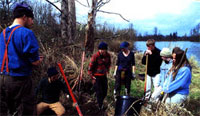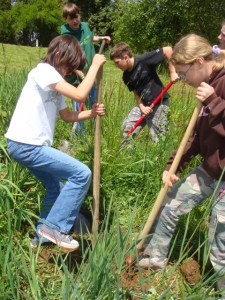Services
Vanishing Ecosystems
Prior to European settlement, the Willamette Valley was a mosaic of oak savanna, upland prairie, wet prairie, and riparian woodlands. The coniferous forests typical of Pacific Northwest were not readily found on the valley floor. Over time, human disturbances have fragmented the valley floor’s habitats to varying degrees. The status of the valley’s oak savanna and grasslands is most critical. They rank in the top twenty-one most endangered ecosystems in the United States with less than 1% of their original expanse remaining. The Walama Restoration Project believes that immediate action in the form of habitat rehabilitation and education is the only way to preserve and restore some of the remaining fragments of our region’s native ecology.
Oak Savanna Rehabilitation
 Oak savannas covered several hundred thousand acres of the valley floor prior to European settlement. The savannas were a park-like landscape: grasslands punctuated with either islands of tree groves or large single trees. The Oregon white oak was the dominant species in the savanna and could be found associated with Douglas firs, ponderosa pines, and the California black oak. The savannas were maintained by regular fires that swept through the valley. The fires suppressed the growth of woody vegetation, such as that of Douglas firs. The fires also allowed larger trees ample space to flourish. Fire suppression and colonization has transformed many of the remaining savannas into mixed fir woodlands. With nearly two hundred wildlife species dependent on the Oregon white oak alone, the remaining oak savannas and oak habitat provide some of our region’s most important wildlife habitat. Walama Restoration Project facilitates savanna restoration through woody vegetation removal. Most importantly, we are working to control rival Douglas firs populations on the valley floor. Without active management, these ecosystems will decline and disappear.
Oak savannas covered several hundred thousand acres of the valley floor prior to European settlement. The savannas were a park-like landscape: grasslands punctuated with either islands of tree groves or large single trees. The Oregon white oak was the dominant species in the savanna and could be found associated with Douglas firs, ponderosa pines, and the California black oak. The savannas were maintained by regular fires that swept through the valley. The fires suppressed the growth of woody vegetation, such as that of Douglas firs. The fires also allowed larger trees ample space to flourish. Fire suppression and colonization has transformed many of the remaining savannas into mixed fir woodlands. With nearly two hundred wildlife species dependent on the Oregon white oak alone, the remaining oak savannas and oak habitat provide some of our region’s most important wildlife habitat. Walama Restoration Project facilitates savanna restoration through woody vegetation removal. Most importantly, we are working to control rival Douglas firs populations on the valley floor. Without active management, these ecosystems will decline and disappear.
The Problem with Invasive Species
 The spread of non-native or invasive species has emerged in recent years as one of the most serious threats to biodiversity, undermining the ecological integrity of many native habitats and pushing some rare species to the boundary of extinction. Of the species listed under the Federal Endangered Species Act, 42% owe their decline to invasive species. Invasives have emerged as the second largest cause of plant extinction, and contribute to the decline of our endangered grasslands and oak savanna. With most of the Willamette Valley dominated by non-native vegetation, WRP prioritizes areas of high ecological significance and works in conjunction with community partners to design site-specific protocols for invasive removal.
The spread of non-native or invasive species has emerged in recent years as one of the most serious threats to biodiversity, undermining the ecological integrity of many native habitats and pushing some rare species to the boundary of extinction. Of the species listed under the Federal Endangered Species Act, 42% owe their decline to invasive species. Invasives have emerged as the second largest cause of plant extinction, and contribute to the decline of our endangered grasslands and oak savanna. With most of the Willamette Valley dominated by non-native vegetation, WRP prioritizes areas of high ecological significance and works in conjunction with community partners to design site-specific protocols for invasive removal.
Riparian and Wetland Enhancement
 Riparian forest corridors up to five miles wide once bordered the Willamette River. Cottonwoods, alders, and willows dominated these forests. In higher elevation floodplains, or creek watersheds, Oregon ash, big-leaf maple, grand fir, and Douglas fir forests were abundant. These forested corridors are in decline–often found to span a width of only a few hundred feet. One of the Walama Restoration Project’s foremost objectives is to establish riparian canopies where none exist, or enhance existing canopies through invasive vegetation removal, native vegetation establishment, and bank stabilization. WRP also facilitates wetland enhancement by removing invasive vegetation and re-vegetating areas with the appropriate native species.
Riparian forest corridors up to five miles wide once bordered the Willamette River. Cottonwoods, alders, and willows dominated these forests. In higher elevation floodplains, or creek watersheds, Oregon ash, big-leaf maple, grand fir, and Douglas fir forests were abundant. These forested corridors are in decline–often found to span a width of only a few hundred feet. One of the Walama Restoration Project’s foremost objectives is to establish riparian canopies where none exist, or enhance existing canopies through invasive vegetation removal, native vegetation establishment, and bank stabilization. WRP also facilitates wetland enhancement by removing invasive vegetation and re-vegetating areas with the appropriate native species.
Education and Community Outreach
WRP recognizes ecosystem stewardship as a commitment extending beyond a single generation. We design and implement curriculum for schools and community education programs. Our curriculum emphasizes local habitat awareness and provides opportunities for children and community members to get involved in habitat enhancement projects. Our current classes cover native plant propagation, invasive species removal, active habitat repair, restoration monitoring, mapping, and understanding the value of local habitats and biodiversity.
Future Stewards of the Earth Campaign
The commitment of ecosystem rehabilitation extends beyond a single generation. The Walama Restoration Project is taking an inter-generational approach to our stewardship commitment. We are currently designing and implementing experiential curriculum for local schools and community education programs. Our classes and hands-on workshops are geared to inspire and educate the future stewards of our bioregion. Participants currently are becoming versed in native habitats, native plant propagation, and threats of invasive species. Participants are also involved in hands-on restoration work and habitat monitoring. We cater to all ages, and we plan to expand accessible curriculum by networking with other environmental educators.